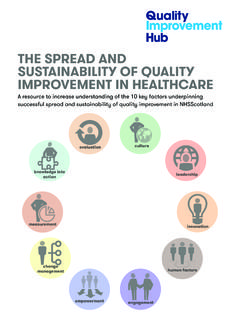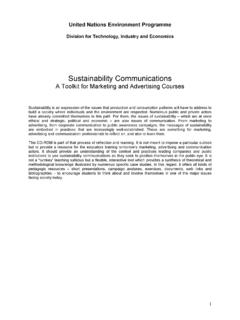Transcription of THE PRINCIPLES OF NEW URBANISM
1 URBANISM promotes the creation and restoration of diverse, walkable, compact,vibrant, mixed-use communities composed of the same components as conventionaldevelopment, but assembled in a more integrated fashion, in the form of completecommunities. These contain housing, work places, shops, entertainment, schools, parks,and civic facilities essential to the daily lives of the residents, all within easy walkingdistance of each other. New URBANISM promotes the increased use of trains and light rail,instead of more highways and roads. Urban living is rapidly becoming the new hip andmodern way to live for people of all ages. Currently, there are over 500 New Urbanistprojects planned or under construction in the United States alone, half of which are inhistoric urban URBANISM is the most important planning movement this century, and is aboutcreating a better future for us all.
2 It is an international movement to reform the design ofthe built environment, and is about raising our quality of life and standard of living bycreating better places to live. New URBANISM is the revival of our lost art of place-making,and is essentially a re-ordering of the built environment into the form of complete cities,towns, villages, and neighborhoods - the way communities have been built for centuriesaround the world. New URBANISM involves fixing and infilling cities, as well as thecreation of compact new towns and villages. THE PRINCIPLES OF NEW URBANISMThe PRINCIPLES of New URBANISM canbe applied increasingly to projects atthe full range of scales from a singlebuilding to an entire Walkability- Most things within a 10-minute walk of home and work- Pedestrian friendly street design (buildings close to street; porches, windows tree-lined streets; on street parking; hidden parking lots; garages in rearlane; narrow, slow speed streets)- Pedestrian streets free of cars in special cases The building of cities is one of man's greatest achievements.
3 -Edmund Bacon in Design of Cities2. Connectivity- Interconnected street grid network disperses traffic & eases walking- A hierarchy of narrow streets, boulevards, and alleys- High quality pedestrian network and public realm makes walking pleasurable3. Mixed-Use & Diversity- A mix of shops, offices, apartments, and homes on site. Mixed-use withinneighborhoods, within blocks, and within buildings- Diversity of people - of ages, classes, cultures, and races4. Mixed HousingA range of types, sizes and prices in closer proximity5. Quality Architecture & Urban DesignEmphasis on beauty, aesthetics, human comfort, and creating a sense of place; Specialplacement of civic uses and sites within community.
4 Human scale architecture &beautiful surroundings nourish the human spirit6. Traditional Neighborhood Structure- Discernable center and edge- Public space at center- Importance of quality public realm; public open space designed as civic art- Contains a range of uses and densities within 10-minute walk- Transect planning: Highest densities at town center; progressively less dense towardsthe edge. The transect is an analytical system that conceptualizes mutually reinforcingelements, creating a series of specific natural habitats and/or urban lifestyle settings. TheTransect integrates environmental methodology for habitat assessment with zoningmethodology for community design. The professional boundary between the natural andman-made disappears, enabling environmentalists to asses the design of the humanhabitat and the urbanists to support the viability of nature.
5 This urban-to-rural transecthierarchy has appropriate building and street types for each area along the continuum. The Transect7. Increased Density- More buildings, residences, shops, and services closer together for ease of walking, toenable a more efficient use of services and resources, and to create a more convenient,enjoyable place to New URBANISM design PRINCIPLES are applied at the full range of densities from smalltowns, to large cities8. Smart Transportation- A network of high-quality trains connecting cities, towns, and neighborhoods together- Pedestrian-friendly design that encourages a greater use of bicycles, rollerblades,scooters, and walking as daily transportation9. Sustainability- Minimal environmental impact of development and its operations- Eco-friendly technologies, respect for ecology and value of natural systems- Energy efficiency- Less use of finite fuels- More local production- More walking, less driving10.
6 Quality of LifeTaken together these add up to a high quality of life well worth living, and create placesthat enrich, uplift, and inspire the human OF NEW URBANISMB enefits to ResidentsHigher quality of life; Better places to live, work, Higher, more stable propertyvalues; Less traffic congestion & less driving; Healthier lifestyle with more walking, andless stress; Close proximity to main street retail & services; Close proximity to bike trails,parks, and nature; Pedestrian friendly communities offer more opportunities to get toknow others in the neighborhood and town, resulting in meaningful relationships withmore people, and a friendlier town; More freedom and independence to children, elderly,and the poor in being able to get to jobs, recreation, and services without the need for acar or someone to drive them; Great savings to residents and school boards in reducedbusing costs from children being able to walk or bicycle to neighborhood schools; Morediversity and smaller, unique shops and services with local owners who are involved incommunity; Big savings by driving less, and owning less cars; Less ugly, congestedsprawl to deal with daily; Better sense of place and community identity with more uniquearchitecture; More open space to enjoy that will remain open space.
7 More efficient use oftax money with less spent on spread out utilities and roadsBenefits to BusinessesIncreased sales due to more foot traffic & people spending less on cars and gas; Moreprofits due to spending less on advertising and large signs; Better lifestyle by livingabove shop in live-work units - saves the stressful & costly commute; Economies of scalein marketing due to close proximity and cooperation with other local businesses; Smallerspaces promote small local business incubation; Lower rents due to smaller spaces &smaller parking lots; Healthier lifestyle due to more walking and being near healthierrestaurants; More community involvement from being part of community and knowingresidentsBenefits to DevelopersMore income potential from higher density mixed-use projects due to more leasablesquare footage, more sales per square foot, and higher property values and selling prices;Faster approvals in communities that have adopted smart growth PRINCIPLES resulting incost / time savings; Cost savings in parking facilities in mixed-use properties due tosharing of spaces throughout the day and night, resulting in less duplication in providingparking; Less need for parking facilities due to mix of residences and commercial useswithin walking distance of each other.
8 Less impact on roads / traffic, which can result inlower impact fees; Lower cost of utilities due to compact nature of New Urbanist design;Greater acceptance by the public and less resistance from NIMBYS; Faster sell out due togreater acceptance by consumers from a wider product range resulting in wider marketshareBenefits to MunicipalitiesStable, appreciating tax base; Less spent per capita on infrastructure and utilities thantypical suburban development due to compact, high-density nature of projects; Increasedtax base due to more buildings packed into a tighter area; Less traffic congestion due towalkability of design; Less crime and less spent on policing due to the presence of morepeople day and night; Less resistance from community; Better overall community imageand sense of place; Less incentive to sprawl when urban core area is desirable; Easy toinstall transit where it's not, and improve it where it is; Greater civic involvement ofpopulation leads to better governanceWAYS TO IMPLEMENT NEW URBANISMThe most effective way to implement New URBANISM is to plan for it, and write it intozoning and development codes.
9 This directs all future development into this URBANISM is best planned at all levels of development:- The single building- Groups of buildings- The urban block- The neighborhood- Networks of neighborhoods- Towns- Cities- RegionsIncreasingly, regional planning techniques are being used to control and shape growthinto compact, high-density, mixed-use neighborhoods, villages, towns, and new train systems (instead of more roads) delivers the best results whendesigned in harmony with regional land planning - known as Transit OrientedDevelopment (TOD). At the same time, the revitalization of urban areas directs andencourages infill development back into city for compact growth, rather than letting it sprawl out, has the potential to greatlyincrease the quality of the environment.
10 It also prevents congestion problems and theenvironmental degradation normally associated with TO OVERCOMEThe most important obstacle to overcome is the restrictive and incorrect zoning codescurrently in force in most municipalities. Current codes do not allow New URBANISM to bebuilt, but do allow sprawl. Adopting a TND ordinance and/or a system of 'smart codes'allows New URBANISM to be built easily without having to rewrite existing equally important obstacle is the continuous road building and expansion taking placein every community across America. This encourages more driving and more sprawlwhich has a domino effect increasing traffic congestion across the region. Halting roadprojects and building new train systems helps reverse this problematic trend.







